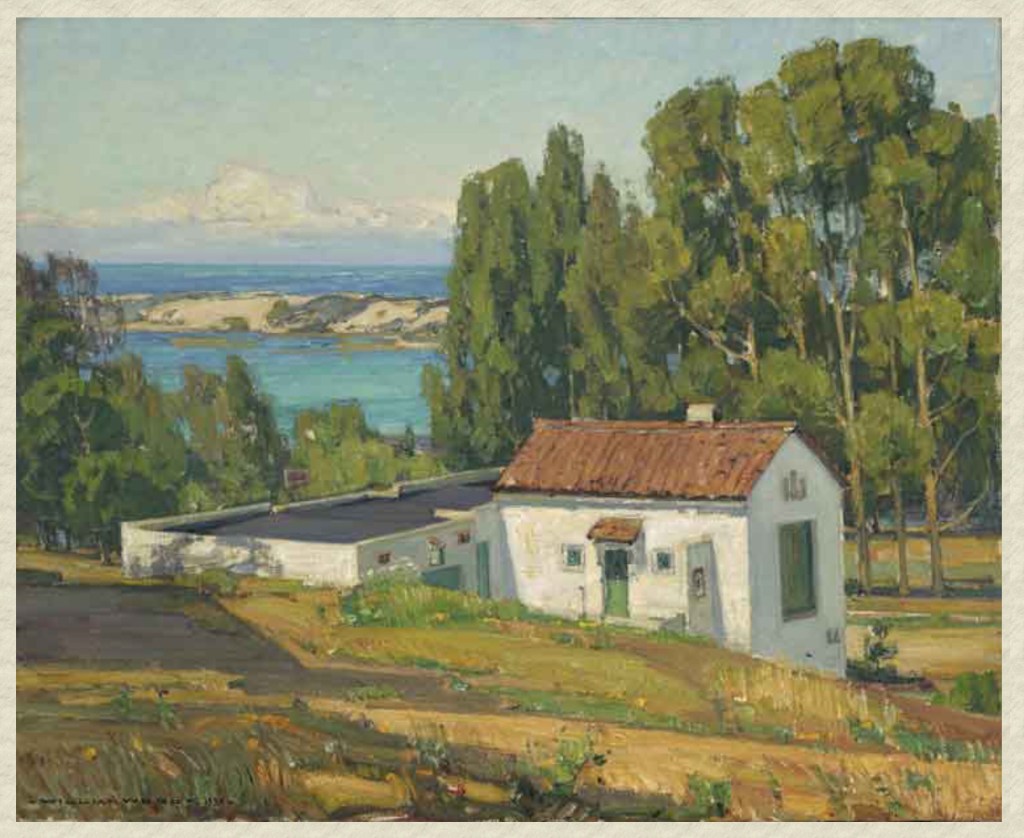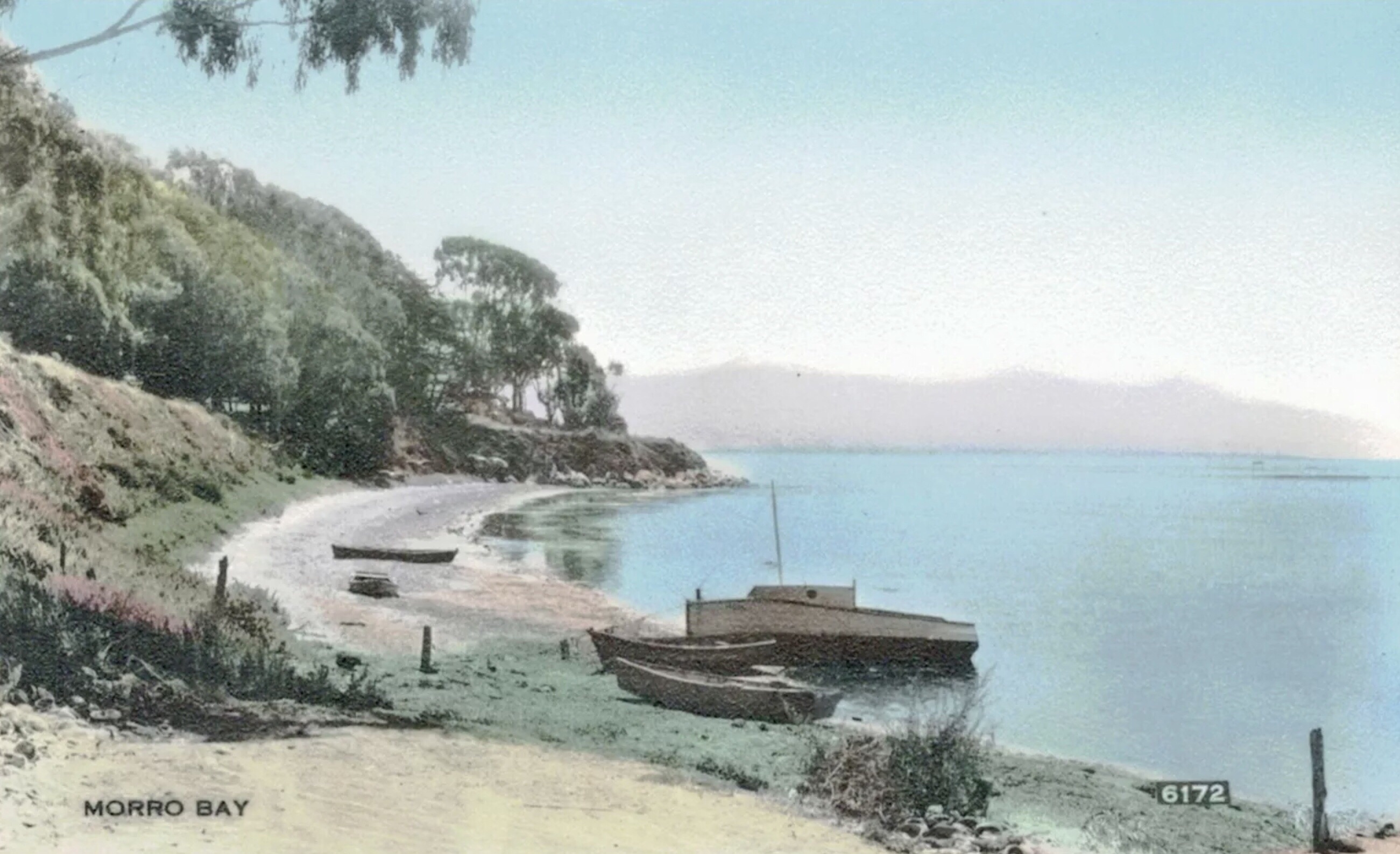
There are a lot of interesting little gems in Morro Bay to look at. I don’t know the history of them all… but I do know a bit. I spent this morning wandering around noting places that stand out to me from south of a line I’ve arbitrarily drawn at Olive street and Ridgeway up to Kern. This is by no means an exhaustive survey of all the interesting architecture… it’s just me wandering around and looking. Many of them are rather quiet and don’t jump out at you… but they provide a feeling that makes this place feel like it does. I’ll go street by street to make it easy to follow along. I’m not gonna do all the streets though. I’m also not gonna include photographs of all these places because it felt too intrusive. You can find them on google earth street view if you’re lazy… but best to just get out and take a walk.
Beginning along the lower State Park Road (aka Main Street) at the south end of town:
Maybe start (or finish)with lunch at Bayside cafe. Order the tri tip tostada… I prefer the black beans but the pinto are good too… (or 50/50!) have them add grilled onions because it’s just better that way. Get an Arnold Palmer to go with.
Walk east from there about half way down the marina parking lot and look north towards the camp ground… across State Park Road. Check out the Board and bat and stone restrooms at the state park. Who designed this little building? I know it was built by the Civilian Conservation Corps. They also did many of the other fixtures around the state park, most notably the gutters along the upper state park road that goes through the golf course known as “park view drive”.

20 State Park Road- Natural History museum at Whites Point. I’m curious who designed this mid century modern building. it’s best viewed from the water or from “windy cove” (the little parking area on the mudflat edge just north of the museum). Walk the little trails around the small little rocky outcropping and above the museum…. Take the stairs up to the top of this rock and check out the Indian bowls carved into the rocks… and the view!
Walk north along state park road on the west side. There’s a trail. Cross past windy cove and the mud flats and look back at the museum. This spot at the mudflats here is where I have spent every King Tide Event at high tide. Back in the seventies the bay crossed the road here once and flooded out into the fairway of the golf course. But since then the road was repaved so now it’s about 2” taller and thus the water hasn’t crossed the road since. I keep waiting… but the water only gets to the west edge of the paving now though. Sandal… the “baykeeper” of Morro Bay used to anchor just at the north end here (google him).
60 State Park Road- the Inn at Morro Bay…. Which to locals will always be known by it’s original name: the Golden Tee. This motel has been highly remodeled with brick pavers and a cottage vibe but was originally a 60’s mid century rat pack sort of place. The main lodge still has a bit of this vibe if you go inside and look at the bar and restaurant. Google “the Golden Tee” and you’ll see lots of period menu’s and postcards etc. They come up on eBay a lot. The buildings were originally designed by local modernist architect John Ross. There was a $920,000 public stock offering offered to fund the build of this place. The folks behind the original corporation were Glenn Kleinhammer, Eugene Morosin, Milton Rohrberg, and Chrome John’s. Architect Ross also designed homes for Kleinhammer and Rohrberg just up the hill a few lots.
Immediately south of the the Inn at Morro Bay is the Heron Rookery on a point known as Fairbanks point. The old Fairbanks house used to be in this spot here long before anything else was in this part of town. Imagine living on this bay front parcel back in the day. The driveway to this house went along the bluff northward up to main street… several thousand feet long… before the motel, and before the condos north of the motel. It entered Main Street just where 199 Main Street is now. The Fairbanks house was a sort of arts and crafts style.
199 Main- cool old brown shingled cottage overlooking the old fuel dock.
225 Main- Gladys’ Castle. Gladys Walton was a silent film star. She covered her house in shells and stones and built both the lighthouse in front of this place and the windmill house across the street.
235 Main- (approx… address) Orval League’s Oyster Cannery. Designed by architect John Badgley. Best views of this building are from the water on a boat. Part of Morro bay’s commercial fishing industry. It’s quite a nice looking mid century design from the water. Hard to see it from the street.
280 Main- Big Sur modernist style redwood concrete and glass home of my dad, architect Gerald (Gerry) Rupp. built early 1950’s. This house marks the southern edge of what was known as “beatnik hill” back in the day. It’s also the southern edge of the artists colony on Cerrito Peak that existed from the 1930’s through the 1970’s.
Take a short side trip up Cypress here… behind 280 Main because in the early 50’s my dad, Gerry Rupp, built 2 other little redwood, glass, concrete and stone modernist houses at 270 and 290 Cypress. SLO Architect Roger Marshal designed a fantastic art studio addition to 290 Cypress on the lot at 280 Cypress but you really can’t see much from the street. A nonagenarian longtime local artist has lived here for approx 70 years. This house began as an A-frame… but then it grew!


301 Main- this mid century house looks right out over the boat launch at the south end of the embarcadero. It’s better to view it from down there. One of the best front decks in town. To get down there walk north to Olive street…turn west.. walk down to the stairs on the bluff and walk south along the embarcadero towards the boat launch.
North of 301 main are several old original cottages between Main Street and the embarcadero that feel same way they did decades ago. Very original Morro Bay feeling here. When you get to Fig street… look at the two red houses across Main and up the hill. Behind these red places…if you look between them… you can just barely see a third red house with white trim. It used to be the only house on this block. It’s a cool old 1930’s crafstman cottage high up on the hill.
Fig street takes off west here for about 150’ and has several original humble cottages that have not changed over the years. Nadine Richards home and art studio are just below the bluff here… at the bottom of Fig…. Accessed by a bridge. But it’s actually on the embarcadero parking lot for the boat launch. She was an artist and a character. She built her house herself down at her parents place south of Fig street… but drug it with a tractor up to where it is now and placed it over her art studio. There’s a ladder between floors. No stairs. Artist Everette Jensen’s art studio and home was the little house behind the hedge on the embarcadero just south of Nadine’s.
340 Olive- Spanish colonial revival. Originally the home of artist Aaron Kilpatrick. He hung out with artist William Wendt… and they both painted all over Cerrito Peak behind here… which they called eagle rock probably because at the top it feels like a big stone eagles nest. … but it’s a volcanic plug. you can access the trail up Cerrito peak from the high point of Cerrito Place just up Olive a tad. Nadine and Aaron and William were all friends and confidants.
370 Olive- known as “the hunting lodge” but I don’t know that story very well. It was also home to artist Charlotte Skinner.
400 Olive- I just like A-frames
Walk up Olive and turn right on Cerrito Place…. Walk up to the bend in the road and look on your right for the “trail” sign between the eucalyptus trees. Hike the short way up to the top. The views are worth it. This is a fantastic small hidden park. Be respectful of neighbors and don’t go near any of the homes. Lots of boulders and cliff… so watch out.
361 Cerrito Peak is just off the south side of the road. Mid century modernist home designed by George Nagano and built circa 1964 as a remodel of a smaller home built a few years earlier… 1957 I think. Look him up in a google search including Morro Bay in the search… amazing old MB history with the Nagano family. This was his own home. It also can be viewed from down on Acacia st looking up. Kent Nagano grew up here as a kid for a time… he’s a world class conductor now.
Head back down and east on Cerrito to Shasta Left, Olive Right, Piney Way right, and ridgeway Left. Walk up ridgeway.

800 Ridgeway- a classic old cottage
805 ridgeway- Spanish colonial revival (with later additions) and with some great trees
850 ridgeway Spanish colonial revival
880 ridgeway. Interesting old triangular parcel with an old MB home. Wish I knew the story.
900 Ridgeway- home and studio of Artist Arther Harold Knott. Later home to his daughter Harleigh. When she died she gave it to Stanford university and they sold it to a couple from SLO who hope to restore it eventually. Harold Knott was a well known artist like Kilpatrick down on Olive. It’s known as “the house of the seven winds”. It is a cape cod style home designed in 1925 as a summer cottage for Mrs G.A. Martell by architects Miller and Warnecke out of San Francisco. She never lived there as far as I know. Harold Knott added his art studio in the SE corner of the lot just after he bought it in 1929 or so.






Walk south down Kern. Watch for cars because there’s no shoulder and it’s a tad sketchy.
350 Kern- cool art deco house. I don’t know the backstory. It’s old though. One of the first 4 or five in this area. Who know’s the story? one of my favorite houses in town.
320 Kern- this place intrigues me because I think it used to also include 310 Kern… before the house at 310 was there. The house at 320 looks sort of Hawaiian. It has a Hawaiian hip roof. The cottage on the rear of the 310 lot, which you have to really snoop to see, also has this Hawaiian hip roof design and appears to have been a guest house for 320. I dunno for certain but would bet. There’s a fantastic back yard here too…. Check google maps!
300 Kern- Spanish colonial revival home with a lovely courtyard and great details. Another of my favorite houses in town. Designed by Louis Noire Crawford. He also designed the old Spanish style Morro Bay elementary school, Cayucos elementary school, Cambria elementary school and many buildings in Santa Maria. The weathervane on top is worth a look too.
246 Kern… looks older than the nearby houses. Don’t know the story. I like it.
140 Kern- Bud Anderson home. He is a famous local. He started the Galley restaurant among other things. Sort of a 60’s or late 50’s slumpstone fake Adobe post and beam rancher. Garage on east end was filled in with bedrooms I think. Sneaky not so secret path to the golf club is behind (east) of this home.
130 Kern- mid century modern designed by Don Smith. South facing courtyard.
101 Bradley- directly across Kern from 130 Kern. This house was home to the “donut lady”. She owned the little donut shop on the waterfront where the beef jerky place is… next to the kite shop at the end of Beach. She sold coffee and donuts to the fishermen and surfers. The Formica countertop was worn completely through next to her cash register where she slid probably 20 million in coins across the counter to buy 25 cent donuts. For some reason there were never more than about 20 donuts in the case. Her name was Ramona… but I forget her last name. She owned a LOT of commercial real estate in MB. Donuts… who knew?
That’s it for this walk… there’s plenty more. Now you have to walk back to your car at the marina. Sorry. Best not to use the golf course. Makes the golfers cranky.











